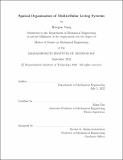Spatial Organization of Multicellular Living Systems
Author(s)
Yang, Haiqian
DownloadThesis PDF (12.35Mb)
Advisor
Guo, Ming
Terms of use
Metadata
Show full item recordAbstract
Cells cooperate as groups to achieve functions at the tissue level, and specific structural characteristics emerge from the local organization of neighboring cells. Analogous to classical physics where transformations in the local structure give rise to phases and phase transitions, the changes in local structures in multicellular assemblies can be essential for a variety of vital processes including morphogenesis, wound healing, and cancer. In this work, we use the two invariants (volume and shear) of the deformation tensor of Delaunay triangles as a pair of quantities to define the local microstates of multicellular living systems. In chapter 3, we develop configurational fingerprints based on these local structures, and extract two parameters, namely the volumetric and shear order parameters, that are reflective of the transitions of local order in the systems. Theoretically, these two parameters form a complete and unique pair of signatures for the local structural order of a multicellular system. The evolution of these two order parameters offers a robust and experimentally accessible way to map the phase transitions in expanding cell monolayers, and during embryogenesis and invasion of epithelial spheroids. In chapter 4, We show by both simulations and experiments that volume follows a k-Gamma distribution, and shear follows an exponential distribution. We further propose two temperature-like quantities for cell assemblies, in which sense we show the periphery of an extravasating epithelial monolayer is ‘hotter’ than the core.
Date issued
2022-09Department
Massachusetts Institute of Technology. Department of Mechanical EngineeringPublisher
Massachusetts Institute of Technology